Here's Anglo-Saxon Lyre Mark 1
Here is some information on the first of the lyres that I built. This has been the most educational of my instruments - in other words, it has had the most problems and failures, so it has taught me a great deal. I am currently working on the second lyre, to correct the problems with the first. I hope to have it finished and playing to bring it to QPT with the other instruments.
This project is not a project in itself, but a primary test bed for methods and techniques I will use to build a Crwth - which if you don't know what it is, you will have to wait or look it up yourself - it is such an interesting instrument that there is not room here for discussion on it. Let it suffice to say it is Welsh, it is a hybrid of 2 instrument design philosophies (doing each precisely half-way), it has a most marvelous sound, and it is possibly the only string instrument I know that could be fatal if you fell on it while playing.
Things I learned while building the Lyre.
American White Oak is strong enough to stand up to nylon or gut strings, but not steel wires (at least not in 1 inch thicknesses.
"Ja Bjorn, squeal like a pig" could have been uttered in period with the proper musical accompaniment.
Having no nut is a survivable, but takes some getting used to.
Running by the bridge sounds just a little too hillbilly to me, but playing at the pins is almost civilized
It only takes a half an inch of airspace to get the attention of the room. And instruments don't really need holes in the front.
If you are curious as to what any of those thing mean, contact me personally, I'll explain.
 Click here for a sound clip (my playing, not very good but you'll get
the idea)
Click here for a sound clip (my playing, not very good but you'll get
the idea)
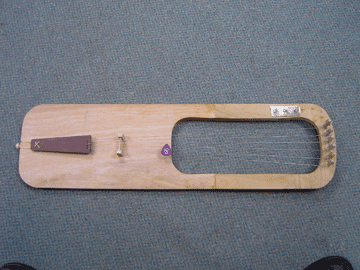
Top view of the lyre. White oak, 1 inch thick, body hollowed up into the arms. Birch ply with an Oak face for the soundboard. Dimensions are 30" x 8" x 1"
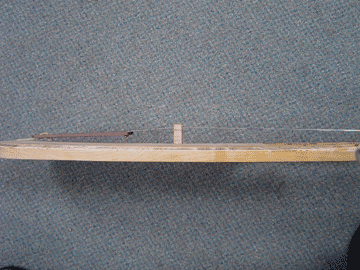
Side view at the bridge, showing the position and height of the bridge and tailpiece. Yes, there is a warp in the entire lyre caused by the tension of the wires.
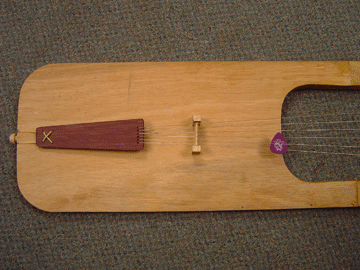
Closeup of soundbox and soundboard area, with bridge and tailpiece. The bridge is castle-shaped made of maple. Period bridges were wood, metal, bone, horn, and amber.
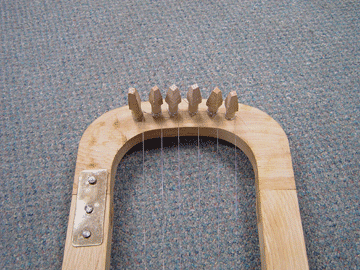
Peghead area. Hand-cut pegs of maple. The brass support on the bass side is because of the intense tension put on the head joint by the steel strings. The treble side isn't as bad off, and since I am building a better instrument, I decided not to put the effort into this one to put the brass on. Maybe I will rework this instrument and cut the joinery different, and brass sleeve the joints, and string it with nylon for a good loaner instrument - it does still sound very nice.
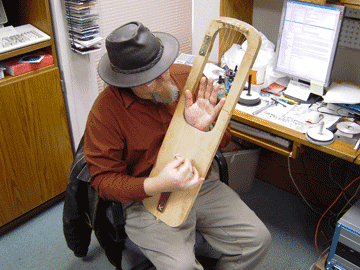
Here I am, preferred playing style. Stop the strings you don't want to hear from behind, strum from the front. As you get closer and closer to the bridge, the tinny sound of a resonator banjo appears, and up at the tuning pegs, the sound is more harp-like. It took about 5 minutes after first stringing to start to play cool medieval melodies and chord progressions - it is a VERY easy instrument to get the basics of, even without instruction.
Here is some information on the first of the lyres that I built. This has been the most educational of my instruments - in other words, it has had the most problems and failures, so it has taught me a great deal. I am currently working on the second lyre, to correct the problems with the first. I hope to have it finished and playing to bring it to QPT with the other instruments.
This project is not a project in itself, but a primary test bed for methods and techniques I will use to build a Crwth - which if you don't know what it is, you will have to wait or look it up yourself - it is such an interesting instrument that there is not room here for discussion on it. Let it suffice to say it is Welsh, it is a hybrid of 2 instrument design philosophies (doing each precisely half-way), it has a most marvelous sound, and it is possibly the only string instrument I know that could be fatal if you fell on it while playing.
Things I learned while building the Lyre.
American White Oak is strong enough to stand up to nylon or gut strings, but not steel wires (at least not in 1 inch thicknesses.
"Ja Bjorn, squeal like a pig" could have been uttered in period with the proper musical accompaniment.
Having no nut is a survivable, but takes some getting used to.
Running by the bridge sounds just a little too hillbilly to me, but playing at the pins is almost civilized
It only takes a half an inch of airspace to get the attention of the room. And instruments don't really need holes in the front.
If you are curious as to what any of those thing mean, contact me personally, I'll explain.
 Click here for a sound clip (my playing, not very good but you'll get
the idea)
Click here for a sound clip (my playing, not very good but you'll get
the idea)
Top view of the lyre. White oak, 1 inch thick, body hollowed up into the arms. Birch ply with an Oak face for the soundboard. Dimensions are 30" x 8" x 1"

Side view at the bridge, showing the position and height of the bridge and tailpiece. Yes, there is a warp in the entire lyre caused by the tension of the wires.

Closeup of soundbox and soundboard area, with bridge and tailpiece. The bridge is castle-shaped made of maple. Period bridges were wood, metal, bone, horn, and amber.

Peghead area. Hand-cut pegs of maple. The brass support on the bass side is because of the intense tension put on the head joint by the steel strings. The treble side isn't as bad off, and since I am building a better instrument, I decided not to put the effort into this one to put the brass on. Maybe I will rework this instrument and cut the joinery different, and brass sleeve the joints, and string it with nylon for a good loaner instrument - it does still sound very nice.

Here I am, preferred playing style. Stop the strings you don't want to hear from behind, strum from the front. As you get closer and closer to the bridge, the tinny sound of a resonator banjo appears, and up at the tuning pegs, the sound is more harp-like. It took about 5 minutes after first stringing to start to play cool medieval melodies and chord progressions - it is a VERY easy instrument to get the basics of, even without instruction.
A very fun instrument, it is more
than I had expected. I will post more detailed construction
photos of this next lyre on another page.
